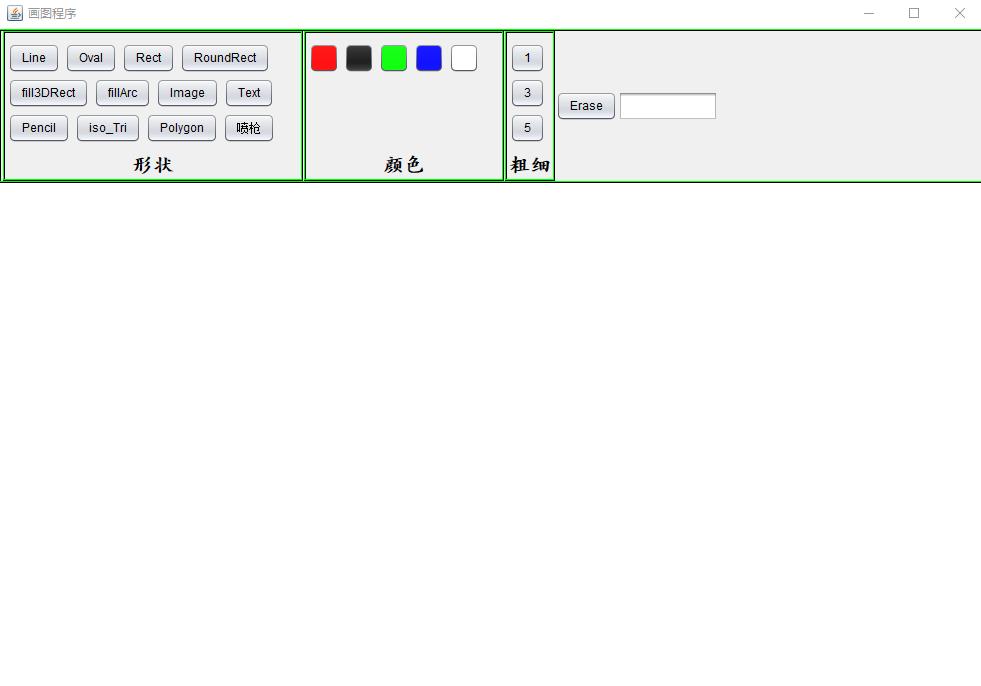JAVA 画图板实现(基本画图功能+界面UI)界面实现
Posted ITryagain
tags:
篇首语:本文由小常识网(cha138.com)小编为大家整理,主要介绍了JAVA 画图板实现(基本画图功能+界面UI)界面实现相关的知识,希望对你有一定的参考价值。
/*文章中用到的代码只是一部分,需要源码的可通过邮箱联系我 1978702969@qq.com*/
这段时间在学JAVA的swing界面开发,试着做了个画图板。实现了直线、曲线、喷枪、矩形、圆形、文字、橡皮等操作,感觉收获很大。
既然要做画图板,那最好的参考当然是windows系统自带的画图啦!虽然技术有限不能做的一模一样,但感觉还是能看(手动滑稽)。下面就讲讲如何实现了。
首先不用想,肯定是先把界面做好了(这是我做的界面,emmmmmm。。。。功能和界面都还有待完善)
注:代码已上传至github:https://github.com/leo6033/Java_Project

仔细看一看大概就能想到怎么实现了,首先创建一个DrawMain类继承(extends)JFrame类
public class DrawMain extends JFrame {
public static void main(String[] args) {
DrawMain dm = new DrawMain();
dm.setLookAndFeel();
dm.initUI();
}
/**
* 为主面板设置皮肤,这个是我随便找的一个,具体可以自己去研究
*/
public void setLookAndFeel() {
try {
UIManager.setLookAndFeel("com.sun.java.swing.plaf.nimbus.NimbusLookAndFeel");
} catch (Exception e) {
e.printStackTrace();
}
}
public void initUI() {
this.setTitle("画图程序");
this.setSize(1000, 700);
this.setDefaultCloseOperation(3);
this.setLocationRelativeTo(null);
this.setLayout(new BorderLayout());
this.setVisible(true);
}
这当然只是主界面啦,那后面该怎么弄呢?上面可以有那么多个分区当然需要再放几个容器类型的组件啦。就是组件里放组件了,那么此时布局的选择很重要,首先利用主界面是BroderLayout,就在北方向上放上一个JPanel上去咯
JPanel NorthJPanel = new JPanel(); NorthJPanel.setLayout(new FlowLayout(FlowLayout.LEFT, 1, 0)); NorthJPanel.setBackground(new Color(240, 240, 240));//设置背景色
//NorthJPanel.setBorder(BorderFactory.createEtchedBorder(new Color(0, 0, 0), new Color(0, 255, 0)));设置边框,可以看看有什么区别 this.add(NorthJPanel, BorderLayout.NORTH);
运行一下,再拉拉边框,有什么发现没有?这个刚贴上去的组件大小会随着你拉边框而改变,所以我们应该再贴一个JPanel到这个JPanel里,然后再设置好大小防止改变
JPanel InNorthJPanel = new JPanel(); InNorthJPanel.setLayout(new FlowLayout(FlowLayout.LEFT, 1, 0)); InNorthJPanel.setPreferredSize(new Dimension(900, 150)); InNorthJPanel.setBackground(new Color(240, 240, 240)); NorthJPanel.add(InNorthJPanel);
然后该怎么做呢?设置分区,自然,每个分区就是一个JPanel组件
/*
* 形状区域
*
* @param ShapeJPanel 形状区域的面板,界面布局
*
* @param InShapeJPanel 形状区域中放置形状选项的面板,放在ShapeJPanel中,流式布局
*
* @param InShapeLabel 形状区域中标识区域的标签,放在ShapeJPanel中
*/
JPanel ShapeJPanel = null;
ShapeJPanel = createJPanel(InNorthJPanel);
ShapeJPanel.setPreferredSize(new Dimension(300, 150));
JPanel InShapeJPanel = new JPanel();
InShapeJPanel.setLayout(new FlowLayout(FlowLayout.LEFT, 5, 5));
InShapeJPanel.setBackground(null);// 设置背景色透明
InShapeJPanel.setOpaque(false);
InShapeJPanel.setPreferredSize(new Dimension(300, 110));
ShapeJPanel.add(InShapeJPanel, BorderLayout.NORTH);
JLabel InShapeLabel = null;
InShapeLabel = createJLabel("形状", ShapeJPanel);
/*
* 颜色区域
*
* @param ColorJPanel 颜色区域面板,界面布局
*
* @param InColorJPanel 颜色区域中放置颜色选项的面板,放在ColorJPanel中,流式布局
*
* @param InColorLabel 颜色区域中标识区域的标签,放在ColorJPanel中
*/
JPanel ColorJPanel = null;
ColorJPanel = createJPanel(InNorthJPanel);
JPanel IncolorJPanel = new JPanel();
IncolorJPanel.setPreferredSize(new Dimension(200, 110));
IncolorJPanel.setBackground(null);// 设置背景色透明
IncolorJPanel.setOpaque(false);
IncolorJPanel.setLayout(new FlowLayout(FlowLayout.LEFT, 5, 5));
ColorJPanel.add(IncolorJPanel, BorderLayout.NORTH);
JLabel InColorLabel = null;
InColorLabel = createJLabel("颜色", ColorJPanel);
/*
* 粗细设置区域
*
* @param StrokeJPanel 粗细设置区域面板,界面布局
*
* @param InStrokeJPanel 粗细设置区域中放置粗细选项的面板,放在StrokeJPanel中,流式布局
*
* @param InStrokeLabel 粗细设置区域的标签,放在StrokeJPanel中
*/
JPanel StrokeJPanel = null;
StrokeJPanel = createJPanel(InNorthJPanel);
StrokeJPanel.setPreferredSize(new Dimension(50, 150));
JPanel InStrokeJPanel = new JPanel();
InStrokeJPanel.setPreferredSize(new Dimension(50, 110));
InStrokeJPanel.setBackground(null);
InStrokeJPanel.setOpaque(false);
InStrokeJPanel.setLayout(new FlowLayout(FlowLayout.LEFT, 5, 5));
StrokeJPanel.add(InStrokeJPanel, BorderLayout.NORTH);
JLabel InStrokeLabel = null;
InStrokeLabel = createJLabel("粗细", StrokeJPanel);
可能你会发现,我在里面用了createJLabel()和createJPanel(),这是我写的方法,因为在创建过程中很多代码是重复的,自己写两个方法用在里面代码看上去会舒服很多,而且也能少写很多代码。两个方法的具体实现
private JPanel createJPanel(JPanel InNorthJPanel) {
JPanel jp = new JPanel();
jp.setBorder(BorderFactory.createEtchedBorder(new Color(0, 0, 0), new Color(0, 255, 0)));
jp.setPreferredSize(new Dimension(200, 150));
jp.setBackground(new Color(240, 240, 240));
InNorthJPanel.add(jp);
return jp;
}
private JLabel createJLabel(String s, JPanel jp) {
JLabel jl = new JLabel(s);
jl.setHorizontalAlignment(JLabel.CENTER);// 设置对其格式剧中
jl.setFont(new Font("楷体", Font.BOLD, 20));// 设置字体 样式 大小
jp.add(jl, BorderLayout.SOUTH);
return jl;
}
这样上面的边框就做好了,接下来就是贴按钮和文本框之类的了
/*
* 放置按钮
*/
String[] typeArray = { "Line", "Oval", "Rect", "RoundRect", "fill3DRect", "fillArc", "Image", "Text", "Pencil",
"iso_Tri", "Polygon","喷枪", "Erase" };
Color[] colorArray = { Color.red, Color.black, Color.green, Color.BLUE, new Color(255, 255, 255) };
String[] widthArray = { "1", "3", "5" };
JTextField text = new JTextField();
text.setPreferredSize(new Dimension(100, 30));
DrawListener dl = new DrawListener(this, text, list);
for (int i = 0; i < typeArray.length; i++) {
JButton button = new JButton(typeArray[i]);
InShapeJPanel.add(button);
button.addActionListener(dl);
if(i>=12)
{
JButton button1 = new JButton(typeArray[i]);
InNorthJPanel.add(button);
button1.addActionListener(dl);
}
}
for (int i = 0; i < colorArray.length; i++) {
JButton button = new JButton();
button.setBackground(colorArray[i]);
button.setPreferredSize(new Dimension(30, 30));
IncolorJPanel.add(button);
button.addActionListener(dl);
}
for (int i = 0; i < widthArray.length; i++) {
JButton button = new JButton(widthArray[i]);
InStrokeJPanel.add(button);
button.addActionListener(dl);
}
InNorthJPanel.add(text);
这样,我们的界面就做好了。
以上是关于JAVA 画图板实现(基本画图功能+界面UI)界面实现的主要内容,如果未能解决你的问题,请参考以下文章